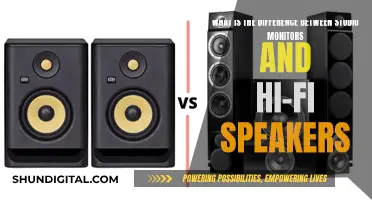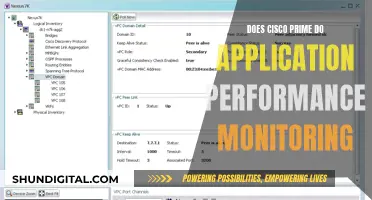
IPS stands for in-plane switching, a type of LED display panel technology. IPS monitors are known for their superior colour accuracy and wide viewing angles, making them ideal for professional work in art, graphics, photography, and video editing. They are also commonly used for gaming, as they offer high refresh rates and response times. However, IPS panels are typically more expensive than other display technologies.
| Characteristics | Values |
|---|---|
| What is IPS? | In-plane switching |
| Type of display | LED (a form of LCD) |
| Main use | Professional work |
| Image quality | Great |
| Colors | Vibrant |
| Viewing angles | Wide |
| Response times | Faster than VA, slower than TN |
| Refresh rates | Up to 360Hz |
| Response times (in ms) | 1 |
| Price | Expensive |
| Power consumption | High |
| Heat generation | High |
What You'll Learn

IPS vs TN and VA panels
IPS (in-plane switching) is a screen technology for liquid-crystal displays (LCDs). It was developed by Hitachi in the mid-1990s to improve the colours and viewing angles of thin-film-transistor (TFT) displays. IPS panels are defined by the shifting patterns of their liquid crystals, which are aligned in parallel to produce rich colours.
TN (twisted nematic) panels are the oldest LCD panel type. They are the most widely used and produced, and they are a popular mainstream display technology for desktop and laptop displays. TN panels are the cheapest option and are favoured by competitive gamers due to their fast response times and refresh rates. However, they have the poorest colour accuracy and contrast ratio, as well as limited viewing angles.
VA (vertical alignment) panels are considered the sweet spot between IPS and TN. They are widely used for flat-screen TVs and are ideal for blocking out backlight, ensuring better uniformity in contrast ratios and black levels. VA panels have a good response time and viewing angles similar to IPS technology, but they have slower pixel transitions, resulting in blurred trails in fast-moving visuals.
IPS panels offer the greatest range of colour-related features and are considered the gold standard for photo editing and colour-critical pro uses. They are also versatile and can be used in different monitor styles, such as ultrawide or curved monitors. However, IPS panels are more expensive to produce and have slower response times than TN panels.
In summary, the best panel type depends on the specific use case and personal preferences. TN panels are ideal for competitive gaming, while VA panels are a good choice for multimedia consumption and gaming. IPS panels are favoured by professionals who require accurate and consistent colours, such as graphic designers, photographers, and video editors.
Monitoring Children's Internet Usage: A Guide for Parents
You may want to see also

IPS monitor uses
IPS (in-plane switching) monitors are a type of LED display panel technology. They are known for their superior image quality, particularly in terms of colour accuracy and consistency, as well as their wide viewing angles.
IPS monitors are ideal for professionals requiring colour accuracy, such as graphic designers, CAD engineers, pro photographers, and video editors. They are also suitable for technology enthusiasts, higher-level business/home use, and gamers who value image quality over response time.
IPS monitors offer ultra-wide 178-degree vertical and horizontal viewing angles, providing outstanding colour when viewed from different angles. They also have faster response times and better colour/contrast than many VA (vertical alignment) and TN (twisted nematic) panels.
IPS monitor variations include S-IPS, H-IPS, e-IPS, P-IPS, and PLS (Plane-to-Line Switching), which is the latest iteration. These variations are collectively referred to as "IPS-type" panels, offering the major benefits associated with IPS monitors, including great colour and ultra-wide viewing angles.
IPS monitors support professional colour space technologies, such as Adobe RGB, and can display more colours, improving colour accuracy. While they used to have slower response times and lower contrast ratios, recent advancements have improved IPS monitor response times, making them suitable for gaming.
IPS monitors are generally more expensive than TN and VA panels, but they offer superior image quality, making them a popular choice for users seeking rich colours and wide viewing angles.
How Monitor Size Impacts Graphics Card Performance
You may want to see also

IPS monitor technology
IPS panels are defined by the shifting patterns of their liquid crystals, which are aligned in parallel to produce rich colours. These monitors were designed to overcome the limitations of TN panels, with the liquid crystal's ability to shift horizontally creating better viewing angles. IPS monitors continue to be the preferred choice for users who require colour accuracy and consistency.
IPS monitors offer ultra-wide 178-degree vertical and horizontal viewing angles, making them ideal for graphic designers, CAD engineers, pro photographers, and video editors. IPS panels also offer more displayable colours, which help improve colour accuracy. They support professional colour space technologies, such as Adobe RGB, and are less prone to colour/contrast shift issues seen with some VA displays.
While IPS panels initially had slower response times than TN panels, recent advancements have improved IPS response times to the point of satisfying gamers, resulting in a rise in popularity for IPS monitors in the gaming community. IPS panels can now offer up to 360Hz refresh rates, making them some of the fastest on the market.
IPS panels have some drawbacks, including a below-average static contrast ratio, potential white glow from off-angles when viewing dark content, and more motion blur than TN monitors. Additionally, IPS panels require up to 15% more power than TN panels and are more expensive to produce.
Keyboard and Mouse Control for the Asus VP228H Monitor
You may want to see also

IPS monitor drawbacks
IPS (in-plane switching) monitors are a type of LCD (liquid-crystal display) that uses a layer of liquid crystals sandwiched between two glass surfaces to produce an image. While IPS monitors offer superior colour accuracy, consistency, and viewing angles compared to TN (twisted nematic) and VA (vertical alignment) panels, they do have some drawbacks. Here are some of the disadvantages of IPS monitors:
Slow Response Times
IPS monitors have slower response times than TN panels, which can result in more motion blur during fast-paced or competitive gaming. This makes TN panels the preferred choice for gamers who require rapid response times and low latency. However, advancements in IPS technology have improved response times to satisfy casual gamers who value image quality.
Potential White Glow and Backlight Bleeding
Lower-end or off-brand IPS monitors may exhibit a potential white glow from off-angles when viewing dark content. Additionally, IPS panels can be vulnerable to backlight bleeding, which can be noticeable in dark rooms. This issue is not unique to IPS and can also affect VA panels.
Higher Cost
IPS panels are generally more expensive to produce than TN panels, making them a higher-cost option for consumers. The superior image quality and viewing angles of IPS come at a premium price. However, IPS panels may be worth the investment for users who require colour accuracy and consistency.
Inefficient Power Consumption
IPS displays consume more power than TN panels, requiring up to 15% more battery power. This makes IPS less suitable for battery-operated, low-power devices. The stronger backlighting required by IPS panels contributes to higher power consumption.
Asus Monitor: Is Renewed a Smart Choice?
You may want to see also

IPS monitor alternatives
IPS stands for in-plane switching, a type of LED (a form of LCD) display panel technology. IPS panels are known for having the best colour accuracy and viewing angles among the other main types of display panels, TN (twisted nematic) and VA (vertical alignment).
TN Panels
TN panels are the oldest and most affordable type of LCD panel. They are popular among competitive gamers as they offer the fastest response times and refresh rates on the market. However, they have narrower viewing angles and lower colour accuracy than IPS panels.
VA Panels
VA panels were developed to improve upon the drawbacks of TN panels. They offer higher contrast ratios, better colour reproduction, and wider viewing angles. VA panels are ideal for applications that require deeper blacks and higher contrast ratios, such as video editing or playing games focused on rich imagery.
OLED Panels
OLED panels differ from LCDs as they use positively/negatively charged ions to light up each pixel individually, while LCDs use a backlight. OLEDs can produce darker blacks and avoid screen glow. However, they are usually pricier than other types of display panels.
PLS Panels
PLS (Plane-to-Line Switching) panels were introduced by Samsung as an alternative to IPS panels. They offer similar performance and features but with improved viewing angles, brightness, and reduced production costs.
AHVA Panels
AHVA (Advanced Hyper-Viewing Angle) panels are another IPS-type technology developed by AU Optronics. They offer similar performance and specifications to IPS and PLS panels. AHVA panels were the first to support a 144Hz refresh rate.
Measuring Monitor Size: Easy Tricks Without a Ruler
You may want to see also
Frequently asked questions
IPS stands for in-plane switching, a type of LED display panel technology. IPS panels are known for their superior colour accuracy and wide viewing angles.
IPS panels offer improved colour accuracy and consistency, wider viewing angles, and faster response times than other LCD panels.
IPS panels are typically more expensive and have slower response times than other LCD panels. They also consume more power, which can lead to overheating issues.







